Hydrofoil Windsurfing: Mechanics and Evolution


Intro
In recent years, a thrilling evolution has taken place in the realm of wind-driven sports, particularly where hydrofoil technology meets windsurfing. Hydrofoil windsurfing isn’t just a trend; it represents a remarkable shift in how enthusiasts engage with water and wind. As sails capitalize on the seemingly endless power of the wind, hydrofoils lift boards above the water, offering a sensation that feels like flying.
This piece will unfold the layers that encapsulate hydrofoil windsurfing, bringing a mix of science, technique, and passion to the forefront. Here, we will examine the mechanics behind this hybrid sport and how it redefines ones experience on water, opening doors to new heights, both literally and figuratively.
Gear Insights
Latest Gear Reviews
When venturing into the world of hydrofoil windsurfing, having the right gear is akin to having the best tools in a toolbox. Recent models like the Naish Hover Glider and Slingshot's Wizard offer advanced designs that blend lightweight materials with superior performance capabilities. The modern hydrofoils of today are way more than just metal fins; they incorporate aerodynamics drawn from aerospace engineering.
Key features to consider in today’s hydrofoil gear include:
- Weight: Lighter materials improve maneuverability and reduce fatigue.
- Stiffness: A stiffer foil allows for better power transfer from the wind to the water.
- Size configuration: Various wing sizes can impact lift and speed; selecting the right balance can make or break the experience.
Essential Gear for Beginners
For those just starting out, the array of options may seem overwhelming. However, beginning with basic gear can set the foundation for mastering hydrofoil windsurfing. Essential gear for beginners typically includes:
- Hydrofoil Set: Look for all-in-one packages that offer compatibility and ease of use.
- Windsurfing Board: A suitable board should have enough width for stability while accommodating hydrofoils. Models like the Starboard Foil X are often recommended for novices.
- Safety Equipment: A quality impact vest is crucial to protect against falls, while a helmet can safeguard against potential head injuries.
Investing in gear that supports learning, rather than complicating it, is paramount. As riders gain proficiency, they can then explore more specialized equipment tailored to advanced techniques and personal preferences.
Techniques and Tips
Advanced Tricks and Techniques
Once mastering the basics, pushing the envelope of what’s possible on hydrofoils becomes the next goal. Tricks such as the toe-side jump or downwind 360s require precise control and an understanding of lift dynamics. Practicing these techniques takes patience and commitment; the learning curve can test even the most determined riders.
Having clear focus on body positioning can tremendously impact the success of performing tricks:
- Center of Gravity: Maintain a low center of gravity to stabilize control.
- Sail Trim: Adjusting sail position in accordance with wind gusts enhances performance significantly.
Safety Practices for Kiteboarders
While hydrofoil windsurfing can be exhilarating, it also demands a keen awareness of safety protocols. Strong wind conditions, for instance, can create tricky situations. Following key safety practices is essential:
- Always check weather conditions before heading out.
- Use a buddy system whenever possible; having a fellow rider can provide extra security on the water.
- Familiarize yourself with local regulations and water rules to ensure a safe ride.
Engaging with the community can offer additional avenues for learning and safety. Online forums, such as those found on Reddit or specialized groups on Facebook, can be invaluable resources for sharing experiences and gaining insights.
By navigating through this intersection of hydrofoil and windsurfing with a solid understanding of gear, techniques, and safety measures, enthusiasts can truly elevate their experiences on the water. By synthesizing the various aspects discussed, a fuller appreciation of hydrofoil windsurfing can emerge, enriching the journey for all who ride the winds.
Understanding Hydrofoils
Hydrofoils are critical in the modern evolution of windsurfing, turning a conventional ride into an exhilarating experience. The importance of comprehending hydrofoils lies not just in their mechanics but in how they transform the dynamics of water sports, particularly windsurfing. With the advancements in technology, incorporating hydrofoils can significantly enhance speed and maneuverability—an essential consideration for enthusiasts seeking to push their limits on the water.
Definition of Hydrofoils
Hydrofoils can be defined as wing-like structures that extend below the water's surface, allowing a vessel to lift above the water at high speeds. By creating lift as they move through water, hydrofoils help to reduce drag. This provides a smoother ride, a key factor for those keen on maximizing performance. Essentially, hydrofoils serve as a vehicle to harness the power of the wind more efficiently, enabling riders to glide above waves rather than through them.
Mechanics of Lift
The mechanics of lift in hydrofoils operate on the fundamental principles of fluid dynamics. As the hydrofoil moves forward, the shape of the foil generates a pressure difference between the upper and lower surfaces. This pressure difference creates lift, allowing the board to ascend above the water, reducing the contact area and, consequently, the drag.
The speed required to achieve lift varies largely based on factors such as foil design, weight distribution, and water conditions. Understanding these dynamics is crucial for windsurfers looking to integrate hydrofoils into their riding style. As thrilling as it may be, proper technique and insight into lift mechanics can greatly improve the overall experience and be the difference between a smooth ride and a turbulent adventure.
Types of Hydrofoils
Hydrofoils come in various types, each tailored to specific needs and conditions. Below are three subcategories to consider:
Foil Design

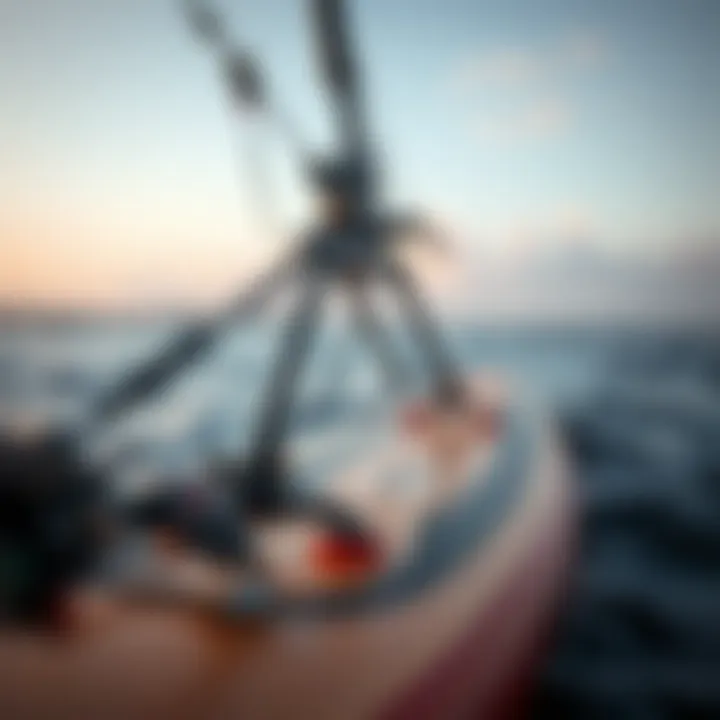
The design of the hydrofoil can have a significant impact on performance. For instance, wider wings may provide better lift at lower speeds, making them suitable for beginners or lighter riders. In contrast, narrower foils, while harder to control, can enable faster speeds and are preferred by advanced windsurfers. Experimentation with different shapes can lead windsurfers to find what aligns best with their style.
Material Composition
When it comes to material composition, hydrofoils are often made from materials like carbon fiber or aluminum. Carbon fiber is lightweight and strong, enabling better performance and durability under the strains of high-speed windsurfing. Aluminum, on the other hand, is more affordable but can be heavier, potentially affecting overall speed. Thus, the choice of materials plays a pivotal role in the overall experience and performance, making it essential for riders to weigh the pros and cons.
Size Variability
Size variability is another crucial aspect of hydrofoils. Larger foils provide increased lift but can be less responsive, making for a different riding experience. Smaller foils, while offering less lift, are often more agile and can be favored in choppy water. Finding the right size is a matter of balancing preferences against conditions expected during rides, hence necessitating thoughtful consideration.
Ultimately, understanding hydrofoils is essential for any serious windsurfer looking to elevate their game. By grasping the fundamental principles and variations of hydrofoils, one can make informed choices toward a more exhilarating and efficient surfing experience.
Windsurfing Fundamentals
Windsurfing is an exhilarating sport that combines elements of sailing and surfing, providing enthusiasts with a unique experience on the water. Understanding the fundamentals of windsurfing is essential for those who want to harness the power of the wind and ride the waves effectively. This section explores the essential elements including equipment, navigation principles, and techniques that are vital for anyone stepping into the world of windsurfing.
Basic Equipment Overview
The right equipment is crucial for a successful windsurfing experience. This section breaks down the three fundamental components of windsurfing gear: sails, masts, and boards. Each one of these pieces plays a significant role in how a windsurfer interacts with the wind and the water.
Sails
Sails are arguably the most important component of windsurfing gear. Their primary function is to catch the wind, enabling propulsion. A key characteristic of sails is their shape, which can drastically influence how efficiently they convert wind energy into forward motion. For this reason, many windsurfers opt for camber-increasing sails, as they help maintain optimal shape while sailing at speed.
What sets different sails apart is their design and material. For instance, some sails use monofilm while others utilize ripstop sailcloth. This gives each sail its own distinct advantages and disadvantages. Monofilm offers lightweight performance but is less durable against wear and tear, while ripstop provides an extended lifespan but can be heavier. Each type requires consideration based on the wind conditions and the sailor's skill level.
Masts
Masts act as the backbone of a windsurfing rig, holding the sail in place and allowing for efficient wind capture. The key characteristic of masts lies in their flexibility. Typically constructed from materials like fiberglass or carbon fiber, masts can vary in stiffness, thus impacting how the sail behaves under load. A stiffer mast allows sails to open more efficiently, which can be a game changer during high-speed maneuvers. One unique feature to be aware of is the compatibility of masts with specific sails. Mismatched rigs can lead to poor performance and frustration for the sailor. Opting for a mast that matches the sail's characteristics is crucial in achieving a harmonious sailing experience.
Boards
Boards are the platform on which a windsurfer stands. Their shape and volume determine how well they float and maneuver on the water. A notable characteristic of boards is their size—larger boards generally provide more stability and are ideal for beginners, while smaller boards promote agility and speed, appealing to more experienced users. An essential aspect of boards is the triggering of hydrofoils, which can elevate the board out of the water for enhanced speeds and reduced drag. However, riders must consider the trade-off; it's easy to overestimate one's skill level and select a board that's too small, leading to challenging experiences, especially for novices.
Principles of Navigation
Navigating while windsurfing isn't as simple as it may seem. The ability to understand wind direction and water currents can significantly impact one's performance on the water. Windsurfers must learn to gauge the wind's behavior—how it shifts and changes, as well as how to position themselves to react effectively. Mastering navigation involves both instinct and the knowledge of local conditions, which can immensely enhance the overall experience.
Common Techniques
Just like any other water sport, windsurfing comes with its own set of techniques to master. Three of the most critical techniques include jibe, upwind sailing, and downwind sailing.
Jibe
Jibe is an important maneuver that allows the windsurfer to change direction while maintaining speed. This method involves shifting the sail across the wind while stepping around the mast. A distinct characteristic of jibe is its fluid nature, allowing for a graceful transition that can be visually satisfying. The maneuver requires practice, but when done correctly, it can offer great satisfaction and improve overall handling skills.
Upwind Sailing
Upwind sailing is all about harnessing the wind to sail against its direction. A key characteristic of this technique involves the knowledge of angles. Successfully navigating upwind is largely about understanding and utilizing the wind's angles to your advantage. It's a challenging skill that greatly benefits experienced sailors, allowing them to return to the starting point without assistance.
Downwind Sailing
Downwind sailing contrasts with the upwind approach as it capitalizes on moving with the wind. This technique is relatively easier since the pull of the sail is more straightforward. The unique feature of downwind sailing is its emphasis on speed and flow, making it especially enjoyable for those seeking high-speed thrills. However, mastering control during this sail can be tricky due to the potential for gusts and sudden shifts in wind speed.
Each of these fundamental components is instrumental in building a solid foundation for windsurfing and prepares enthusiasts for further explorations into hydrofoil integration.
Integrating Hydrofoils into Windsurfing
Integrating hydrofoils into windsurfing opens a fresh chapter in the sport's history. The combination brings together the thrill of gliding above water and the unique mechanics of hydrofoil technology. By using hydrofoils, windsurfers can achieve higher speeds, improved efficiency, and enhanced maneuverability compared to traditional boards. The vital aspect to consider is how adopting hydrofoils can transform the riding experience, offering distinct opportunities to capitalize on wind conditions.
Adapting Equipment
To fully embrace hydrofoil windsurfing, adapting your gear is necessary. This can be a game-changer for many riders looking to take their skillset to new heights. Gear compatibility, in particular, plays a crucial role.
Choosing Compatible Gear
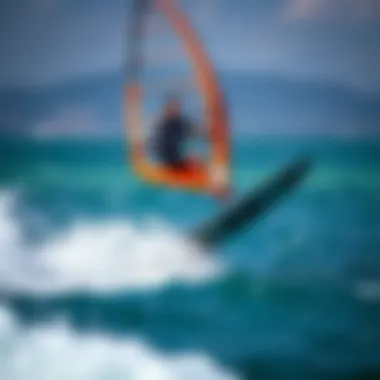
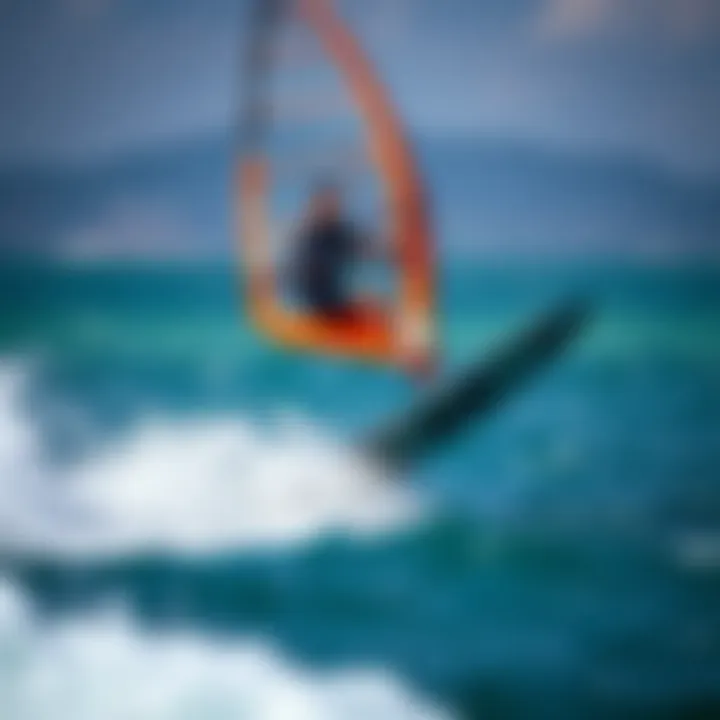
When selecting gear, suitable compatibility is essential. The right combination of board and foil can make or break your hydrofoiling experience. For instance, a larger board may offer stability, while a smaller board enhances agility. Riders must weigh their experience levels and intended conditions when making these decisions.
Additionally, the specific size of the mast can affect responsiveness. An appropriately chosen mast can improve overall balance while on the water. However, make sure the mast’s material and flex characteristics align with hydrofoil setup.
A major advantage of choosing compatible gear is the amplified performance. The tailored setup allows for better speed and precision. Yet, if the components do not mesh well, riders may face unnecessary challenges or a steep learning curve.
Adjusting Sail Sizes
Sail size adjustment is another necessary consideration. When transitioning into hydrofoil windsurfing, the normal sail sizes may not yield optimal performance. The truth is, smaller sails often yield better control and responsiveness in hydrofoiling scenarios.
This shift to smaller sails allows for effective foiling, especially when combined with a hydrofoil's lift capabilities. Aligning sail size to match your navigation level could mean the difference between a smooth flight or turbulence.
On the downside, using a smaller sail may require more strength and technique from the rider, potentially posing a challenge for beginners. Nevertheless, mastering this aspect can lead to significant improvements in agility and overall foiling proficiency.
Techniques for Successful Foiling
Acquiring successful foiling techniques is paramount. This journey starts with mastering the takeoff, which can be likened to learning how to lift off in flight.
Foiling Takeoffs
Foiling takeoffs hinge on balancing power and finesse. Proper technique ensures that a rider efficiently lifts the board above the water, thus harnessing the hydrofoil's lift.
During the takeoff, the positioning of the rider's weight plays a vital role. Leaning back slightly as the board begins to plane will encourage the foil to rise. Achieving this balance becomes crucial in mastering the art of foiling.
While many riders are eager for that moment of airtime, improperly executed takeoffs can lead to faceplants or hard landings. However, with practice, this can become second nature.
Maintaining Speed and Control
Maintaining speed and control is a integral part of successful foiling. As riders gain altitude, the potential for increased speed expands, but this comes with its own set of challenges.
One of the best features of hydrofoils is their ability to slice through chop and rough water while maintaining speed. But, as speed increases, so does the difficulty in managing a stable ride. Leaning back can help counteract unwanted dips or rises.
Getting used to the nuances of control becomes essential when navigating turns or gusts of wind. The unique benefit is that with time, riders often find a rhythm that complements the foil and wind, leading to a gratifying experience.
Challenges Faced
As with any evolving sport, challenges arise when integrating hydrofoils into windsurfing. Recognizing these will help athletes prepare better and adapt efficiently.
Balancing Issues
Balancing issues represent some of the most common hurdles. While riding on a hydrofoil is exhilarating, it demands fine-tuned balance that differs from traditional windsurfing.
The challenge lies in navigating the foil's sensitivity. When transitioning from a stable board to a foil, slight movements can lead to unexpected changes in lift. Finding the right position and adjusting accordingly takes practice.
With patience and persistence, many riders eventually conquer these obstacles and come to enjoy the fluidity that foiling offers.
Understanding Control Mechanisms
Understanding control mechanisms remains another important topic. The sensation of foiling greatly differs from typical windsurfing. Learning how to master the hydrofoil’s responsiveness becomes central to the sport.
Engaging with the right techniques, such as employing the back foot for control during turns, is a valuable skill. Riders need to learn how to utilize their body's position to navigate diverse water conditions effectively.
Though tricky initially, mastering control can turn the thrill of foiling into a seamless dance with the water. Harnessing control mechanisms allows for a deeper connection with both the board and the surroundings.
"Hydrofoil windsurfing not only elevates you above the water but takes your skills and approach to a whole new level."
Thus, as one integrates hydrofoils and windsurfing, understanding both the adaptive gear and mastering essential techniques can enrich the entire experience. Engaging with challenges head-on only serves to bolster one's skills.
Safety and Environmental Considerations
As hydrofoil windsurfing continues to gain traction among water sports enthusiasts, understanding safety and environmental implications becomes crucial. These areas ensure not only the well-being of windsurfers but also the preservation of the natural environments where they practice. Safety protocols are designed to minimize risks while out on the water, allowing for a worry-free experience. On the environmental side, awareness about the impact on local ecosystems helps to foster a sense of responsibility among participants. Both dimensions work together to create a more enjoyable and sustainable way to engage with this thrilling sport.
Safety Protocols
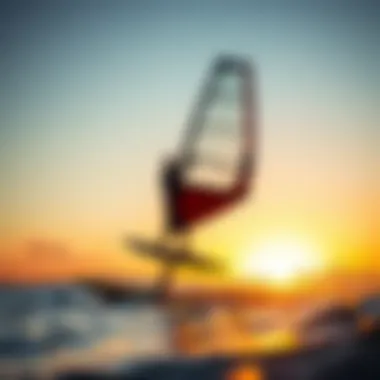
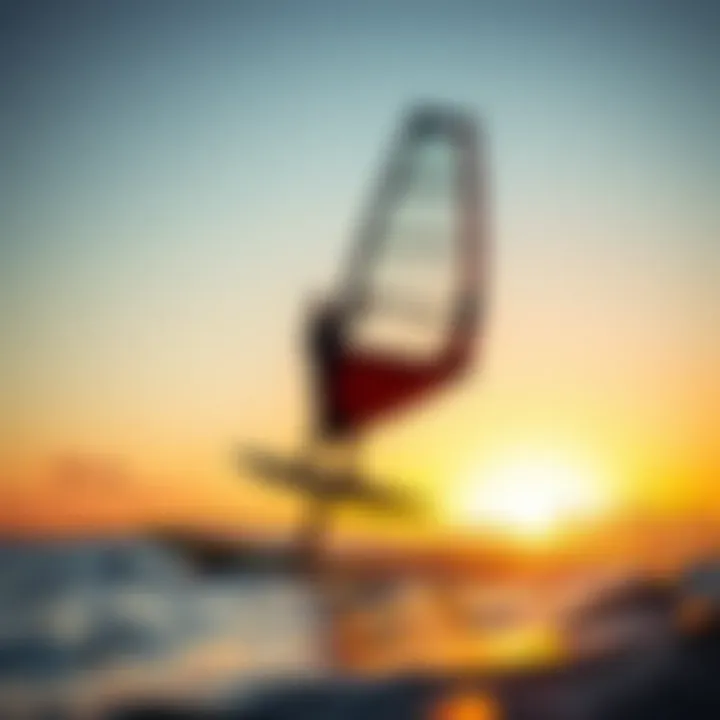
Equipment Inspection
A vital part of the safety protocols revolves around thorough equipment inspection. Before hitting the water, it’s imperative to check your gear. A comprehensive inspection includes looking at the sail for any tears, ensuring the mast is securely attached, and that the hydrofoil is free from any dings or damages. This practice helps to avoid unexpected failures while riding, ensuring a safer outing. One key characteristic of equipment inspection is that it builds confidence. Knowing that your gear is sound adds to the overall enjoyment of the experience.
However, neglecting this crucial step could lead to disastrous outcomes. For instance, a misaligned foil can cause instability, putting the rider at risk. In sum, a habit of routine checks can contribute significantly to safety in hydrofoil windsurfing, empowering enthusiasts to focus on their performance rather than potential mishaps.
Windsurfing Etiquette
Adhering to windsurfing etiquette fosters a culture of respect among riders. This includes understanding right-of-way rules, keeping a safe distance from others, and being aware of your surroundings. Such gestures may seem simple but they promote safer interactions on the water. A fundamental aspect of etiquette is about community trust; when everyone follows the same set of unwritten rules, it reduces the likelihood of accidents.
One notable point is that engaging in courteous behavior can enhance the overall enjoyment of the sport. Respecting others not only ensures everyone's safety but also helps to build camaraderie amongst fellow enthusiasts. Ignoring etiquette, on the other hand, can lead to frustration and dangerous situations, which tells us that it plays a significant role in enhancing safety on the water.
Personal Safety Gear
Wearing appropriate personal safety gear is another cornerstone of safe windsurfing practices. This gear may consist of life vests, impact suits, and helmets. Each piece of equipment serves a distinct purpose — life vests ensure buoyancy, while helmets protect against falls. A standout feature of personal safety gear is its capacity to minimize risk during unforeseen circumstances.
Investing in quality personal safety gear can seem costly upfront but it often proves invaluable when it matters most. Having such safeguards allows a rider to push their limits with extra peace of mind. Nevertheless, it’s worth noting that some riders might see the amount of gear as cumbersome. Yet the trade-off of comfort versus safety emphasizes that proper gear is non-negotiable, especially for those venturing into hydrofoil windsurfing.
Environmental Impact
Wildlife Interaction
Another pivotal aspect to consider is wildlife interaction. Hydrofoil windsurfing occurs in natural habitats where diverse species thrive. Recognizing how our actions can influence local wildlife is essential. For windsurfers, this means keeping a respectful distance from animals in their environment. Understanding when and where wildlife is likely to be encountered helps in preserving ecosystems.
A key characteristic of maintaining good wildlife interaction is becoming mindful of your surroundings. Being aware not only supports the environment but can also enhance your experience. Imagine spotting ospreys swooping in the distance while gliding over the waves—these moments connect you to nature. Conversely, neglecting these principles can disturb habitats and negatively impact wildlife, exemplifying the delicate balance between watersports and nature.
Beach Conservation
Beach conservation efforts play a significant role in safeguarding areas popular for windsurfing. Engaging in actions like participating in local clean-ups or following designated paths helps to maintain the pristine quality of our shores. This commitment highlights a shared responsibility among water sports enthusiasts to protect the environment.
One notable benefit of beach conservation is the enhancement of the scenery you enjoy while windsurfing. Clean and well-maintained beaches create a more pleasant atmosphere for everyone involved. However, overlooking the need for conservation can lead to ruined environments and a decrease in available areas for sport. Upholding conscientious practices ensures that both the beaches and treats everyone can enjoy remain vibrant and accessible for future generations.
"The ocean stirs the heart, inspires the imagination, and brings eternal joy to the soul." - Wyland
In summary, safety and environmental considerations serve as the backbone for a fulfilling and responsible engagement in hydrofoil windsurfing. Fostering practices that emphasize equipment readiness, rider behavior, and ecological mindfulness will enrich the experience both on and off the water.
Future Trends in Hydrofoil Windsurfing
The crossroads of hydrofoil technology and windsurfing stands at the brink of revolutionary changes. As this sport continues to gain traction, understanding the future trends will help enthusiasts stay ahead of the curve. Hydrofoil windsurfing is no longer just a niche; it’s transforming into a dynamic segment that blends innovation with adrenaline. Keeping an eye on emerging trends ensures that both novices and veterans can adapt, learn, and thrive in this evolving environment.
Technological Advancements
Smart Supported Systems
One of the most remarkable trends in hydrofoil windsurfing is the advent of smart supported systems. These are essentially equipped with sensors and tracking devices that provide real-time data about speed, wind direction, and even the rider's posture. A key characteristic of these systems is their ability to enhance safety and performance through data analytics. By monitoring the rider’s movements and environmental conditions, it helps them optimize their technique.
The unique feature of smart supported systems is the integration of mobile applications, letting users analyze their performance after each session. This feedback loop isn’t just a gimmick; it provides a roadmap for improving skills over time. While the initial investment could be higher, the long-term benefits include safer and more enjoyable rides. The downside? Some users find the tech burdensome, preferring a more straightforward, traditional windsurfing experience.
Improved Materials
Materials used in both hydrofoils and boards have come a long way. The shift toward improved materials like carbon fiber and advanced composites has significantly affected performance and durability. These materials are lightweight yet incredibly strong, allowing for better maneuverability and speed on the water. One of their hallmark features is resistance to corrosion and wear, enhancing longevity.
Such materials give hydrofoil enthusiasts the advantage of faster speeds and sharper responsiveness, critical elements in competitive scenarios. However, the trade-off can be higher costs, which may not suit everyone's budget. Many avid enthusiasts argue that the performance gains far outweigh the costs, making improved materials a worthwhile investment in the long run.
Community and Competition
Emerging Competitions
As hydrofoil windsurfing grows, so does its competitive landscape. Emerging competitions are carving out space in the sporting world, showcasing talents from different locales. An intriguing element of these events is their inclusivity, encouraging riders from diverse backgrounds to participate. These competitions often feature unique formats, such as relay races or freestyle events, elevating the challenge.
The key characteristic that makes these competitions attractive is the camaraderie among participants. This not only amplifies the sport’s visibility but also fosters a sense of community. For both seasoned competitors and newcomers, engaging in these events offers invaluable experience. Yet, while these competitions spark excitement, they can also pressure riders to push their limits, which poses a risk to safety.
Cultural Exchanges in Windsurfing
Cultural exchanges in the state of windsurfing have also witnessed a renaissance. As the sport spans various countries and regions, it brings together a medley of techniques, styles, and philosophies. This cross-pollination enriches the sport, offering riders insights into methods that differ from their own. One notable aspect of cultural exchange is the way traditional practices merge with modern innovations.
This sharing leads to fascinating adaptations,, enriching local communities by embracing diverse approaches. The benefit here is the learning opportunity for all flows, regardless of one’s starting point. However, there can be challenges in maintaining the original essence of local practices amid globalization, which might dilute unique cultural identities.
All in all, as hydrofoil windsurfing continues to evolve, technology, community involvement, and cultural interactions will play pivotal roles in shaping its future.















